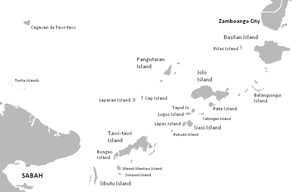Sulu Islands
The Sulu Islands are a region of the Philippines, an island chain that stretches from near Zamboanga, at the southwestern tip of Mindanao, almost to the Malaysian province of Sabah, at the eastern end of Borneo. Politically, they are part of the Philippines but culturally they are close to Malaysia and Indonesia; in particular they are almost entirely Muslim.
In terms of Philippine government administration, they are part of the ARMM or Autonomous Region in Muslim Mindanao, though geographically they are separate islands, not on Mindanao.
| WARNING: This is probably the most dangerous area in the Philippines; all western governments advise strongly against travel to this region. Back in the 19th century, Sulu was a pirate kingdom and Jolo had a huge slave market. Today, there are still some pirates and other bandits. Perhaps more dangerous, there are also several armed Moro (Filipino Muslim) independence groups, including some radical Islamists. See the warning at the top of the ARMM page for more information. | |
Government travel advisories
| |
| (Information last updated Jun 2018) |
Regions

The main islands of the chain, each the center of a province, are Basilan, Sulu and Tawi Tawi. There are many smaller islands, all included in those provinces for administrative purposes.
Cities
- 🌍 Isabela City – the regional center of Basilan, with a mix of Christian and Muslim Filipino culture and some undiscovered sights.
- Jolo – the capital of Sulu Island.
Other destinations
Understand
The Sulu island chain has some pristine beaches and colorful culture. Basilan island has the most vibrant tourism scene, but it has been affected by an ongoing Islamist insurgency. Skirmishes and terror attacks continue to happen throughout the archipelago, and as part of the Autonomous Region in Muslim Mindanao (scheduled to be replaced by the Bangsamoro Autonomous Region in Muslim Mindanao), they are included in travel warnings as well.
Most of the people are either Yakan or Tausug, and there are also a minority of Chavacano speakers from Zamboanga. Other ethnolinguistic groups are the Sama-Bajau (Badjao), who live in the sea and rely heavily on fishing as a source of livelihood.